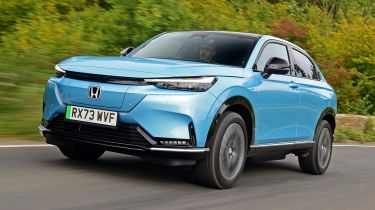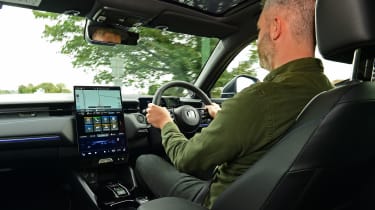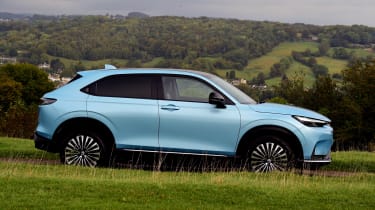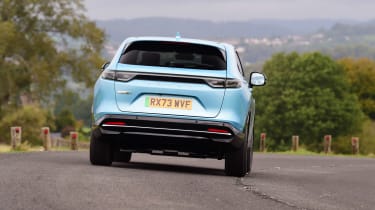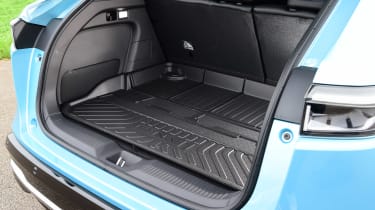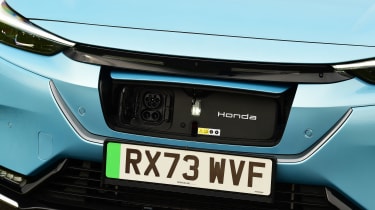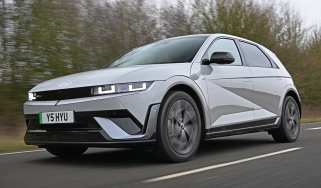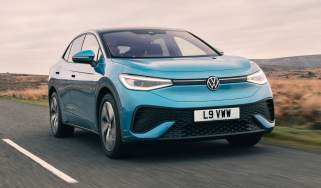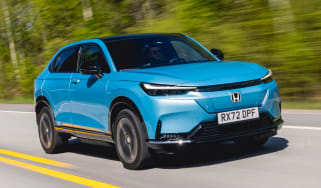Honda e:Ny1 review – a decent EV with a confusing name
“The Honda e:Ny1 is confusingly named and priced, which distracts from its virtues as a decent all-around EV”
Pros
- Contemporary design
- Smart interior
- Five-years free servicing
Cons
- More expensive than rivals
- Limited regenerative braking
- Small boot and no frunk
Verdict – is the Honda e:Ny1 a good car?
Honda’s first electric SUV is a good effort and more usable than the smaller Honda e. It looks pretty good, offers a decent driving range, drives well and has one of Honda’s best interiors yet. Considering its small-ish size, it’s even fairly practical and should suit anyone swapping over from a more conventional family hatchback or crossover. The main downside is the price, because at around £45,000 the e:Ny1 looks seriously pricey, especially given that its on-paper stats lag behind some of its cheaper and larger rivals. Honda’s finance deals don’t help much either, making the Honda tricky to recommend.
Honda e:Ny1 models, specs and alternatives
The Honda e:Ny1 is the Japanese manufacturer’s first all-electric SUV, and only its second EV model to launch in the UK, following the city car-sized Honda e. It will slot into Honda’s predominantly hybrid model range right beneath the larger Honda CR-V, but somewhat awkwardly, it’s similar in size to the Honda HR-V, making Honda’s burgeoning SUV lineup a bit more confusing than is ideal.
While the Honda e:Ny1 also looks somewhat similar to the HR-V, it’s actually based on new underpinnings with enough room for its sizeable 69kWh battery. This is matched with a front-mounted 148bhp electric motor, giving the e:Ny1 the zippy around-town performance we’ve come to expect from EV models.
Its ultimate range figure of up to 256 miles may disappoint some potential EV buyers, and is some way off the 319 miles of the Hyundai Kona Electric. A peak charging speed of 78kW is also some way off the class best, but Honda claims it has prioritised sustained fast charging, without too many peaks or troughs throughout the charging process.
Along with the Kona Electric, the e:Ny1 faces a number of rivals in one of the most competitive classes for EVs. It will need to fend off the Jeep Avenger, Peugeot e-2008, Citroen e-C4 and Vauxhall Mokka Electric.
Trim levels are Elegance and Advance, with the former starting from around £45,000 and the latter around £2,000 on top of that. Standard kit includes a 15.1-inch central screen that’s far better than Honda’s old infotainment displays, synthetic leather seats, heated front seats and wireless smartphone charging. The £47,000 Advance gains a panoramic sunroof, navigation and more extensive camera views.
|
Trim levels |
Power options |
|
|
Honda e:Ny1 alternatives
The small electric SUV class is becoming one of the most hotly contested there is – it’s the heartland for many buyers nowadays. The e:Ny1 isn’t short of rivals, then, which makes it all the more surprising that Honda has priced it above most competitors.
Range, charging & running costs
Despite its similar size to the Honda HR-V hybrid, the e:Ny1 is quite different underneath, making it possible to house a 69kWh battery pack. This is much bigger than the battery found in the Honda e – the brand’s only other EV thus far – and its claimed range of 256 miles is also roughly double the distance.
This doesn’t quite propel the Honda to the top of the charts in the SUV class, though; the Hyundai Kona Electric can manage 305 miles despite its 65kWh battery being slightly smaller, while the MG4 SE Long Range posts a 281-mile range figure. The e:Ny1 looks more competitive against rivals like the Vauxhall Mokka Electric, because even the latest version with its bigger battery can only manage 252 miles.
The Honda’s peak charging speed of 78kW and 10-80% top-up time of around 45 minutes is also behind class leaders. In our time with the car, we found charging speeds tended to drop to around 20kW once above 70%, so trying to get a nearly full charge for a long trip takes some time. The LED strip above the charging port is also a neat touch, pulsing from left to right as the car charges and capable of indicating several messages, while it’s easy to keep track of the state of charge using Honda’s app, too.
The fact that the charging port itself is located in the centre of its nose is also beneficial when pulling into most charging stations, rather than having it on one side or the other.
Like any EV, the e:Ny1 should prove cheap to run, with low-cost taxation for company car drivers, VED (road tax) exemption until 2025 and free access to areas with tariffs like central London. A bigger stumbling block is likely to be its price – starting from around £45,000, the e:Ny1 is far more expensive than some of its key competitors. The MG4 SE Long Range starts from around £30,000, while the Mokka Electric starts from around £29,500 in Griffin trim.
Very few people pay cash for a new EV of course, though Honda’s PCP finance deal offer of £500 per month (with a £5,000 deposit, and 10,000 miles per year) is similar to that of the larger, more family-friendly Tesla Model Y. Honda is at least throwing in another cost-saving perk called the ‘Five Year Care Package’, which includes five years of free servicing, a five-year warranty and five years of UK and European roadside assistance.
|
Model |
Battery size |
Range |
|
Honda e:Ny1 |
69kWh |
256 miles |
Insurance
If you thought EVs were entirely cheap to run, that might not be the case when it comes to getting an insurance quote. Despite having just 148bhp, the e:Ny1 sits in insurance group 43 out of 50 – a band we’d normally associate with high-performance sports models and hot hatches. Electric models do tend to sit in higher groups, but the entry-level MG4 starts in group 27, while the Vauxhall Mokka Electric and Citroen e-C4 start in group 22.
Electric motor, drive & performance
The e:Ny1 is a mixed bag on the road. On first acquaintance it felt like Honda had worked its usual magic, with similarities in feel to the excellent Honda Civic. It leans slightly more in corners owing to its taller stature, but the e:Ny1 feels admirably agile and boasts precise and well-weighted steering. Road noise is somewhat more evident than in the Civic – possibly because of its quiet EV powertrain – but the ride quality on UK roads is quite jittery at lower speeds, taking some of the shine off the car’s behaviour.
There’s some room for improvement when it comes to the Honda’s regenerative braking too, because even if you use the steering wheel-mounted paddles to adjust it, it reverts back to the default setting after a short while. The only way to stop this is to choose Sport mode, but this mode feels rather pointless in a family EV, and there’s no way to make the regen anywhere near strong enough for one-pedal driving, so it’s a little weak overall for our liking.
0-62mph and top speed
In the age of potent EV motors, the Honda’s 148bhp power output sounds rather meagre, yet it’s able to cajole the e:Ny1 from 0-62mph in a decent 7.6 seconds. That’s quicker than you’d expect for an equivalent small petrol or diesel SUV, and the e:Ny1 feels suitably nippy around town thanks to its hefty near-instantaneous pull and lack of gearchanges.
In fact, it might be a bit too nippy for its own good – there’s enough power going to the front wheels to tug at the steering out of junctions, and we found leaving the car in its softer Eco mode helped tame it a little. It sounds ridiculous to say about an electric family car, but the e:Ny1 could benefit from some of the sophisticated suspension know-how from the Civic Type R hot hatch to improve control at the front axle.
|
Model |
Power |
0-62mph |
Top speed |
|
Honda e:Ny1 |
148bhp |
7.6s |
99mph |
Interior & comfort
Honda interiors have a reputation for being hard-wearing, if a little uninspiring. That changed with the Honda e, which featured a somewhat retro-inspired interior mixing faux-wooden trim with lots of screens spanning the dashboard. Rather than copying this, the e:Ny1 goes its own way, and instead seems to take aim at the Tesla Model Y and Ford Mustang Mach-E. It features two large digital screens for a modern look, but material quality is only average.
We didn’t like the sunblind for the panoramic roof in the e:Ny1 because while this is retractable in most cars, you have to manually reposition it on the Honda, which can be fiddly and frustrating.
Infotainment and navigation
The dashboard is dominated by a large 15.1-inch portrait display, which is big enough to be divided into three areas. The top portion shows navigation or Apple CarPlay and Android Auto when your smartphone is connected. Below this is a customisable section for apps, while the bottom portion shows climate controls, and the touchscreen is nicely responsive to inputs.
Sometimes it can be a lot of information all in one place, but it’s a big step up over Honda’s previous software – however, we can’t help thinking that splitting it into sections stops it from being used to its full potential. Unlike the Model Y, there’s also a 10.25-inch driver’s display, clearly showing the car’s speed and other important driving and safety information, but the attention to detail here is lacking because the graphics don’t match up with those of the infotainment screen, making it feel inconsistent.
Elegance trim includes plenty of equipment – as you’d expect for a car costing well over £40,000 – like heated front artificial leather seats, dual-zone air conditioning, a wireless charging pad, power mirrors and folding mirrors.
Given that Advance only costs a few thousand pounds more, it’s likely to prove the most popular, with desirable features like a panoramic sunroof, heated steering wheel, hands-free tailgate and premium stereo. Despite the fact that the premium sound system isn’t developed with a high-end hi-fi brand, we thought the sound quality was fantastic.
Using the My Honda+ app there’s also a Digital Key, which can allow up to five people to lock, unlock and start the car and it’s free for the first year of ownership. The app also enables you to precondition the cabin before you get in so it’s readily warmed up or cooled down for you when you get in.
Key features | |
|
Elegance
|
Advance (Elegance plus…)
|
Practicality & boot space
The Honda e:Ny1’s pricing puts it in a slightly tenuous position, because despite being priced to compete with larger models like the Skoda Enyaq, the e:Ny1 is similar in size to models including the Hyundai Kona Electric.
Luckily there is quite a bit of room for passengers in the back of the Honda, so they won’t feel short-changed at least. Its fairly tall roofline means rear head and knee room is pretty good, and the feeling of backseat space is boosted by a flat floor without a hump running through it.
|
Size comparison | |||
|
Model |
Length |
Width |
Height |
|
Honda e:Ny1 |
4,387mm |
1,790mm |
1,584mm |
|
Hyundai Kona Electric |
4,355mm |
1,825mm |
1,570mm |
|
Vauxhall Mokka Electric |
4,151mm |
1,791mm |
1,531mm |
|
Kia Niro EV |
4,420mm |
1,825mm |
1,570mm |
Boot space
The e:Ny1’s small stature does have an impact on boot space, which at 361 litres, is around 20 litres less than you’ll find in a family hatchback like the Volkswagen Golf. It’s also quite a bit down on the 466 litres in the Hyundai Kona Electric. It does closely match the MG4 (363 litres) and beat the Vauxhall Mokka Electric, however.
The space itself is accommodating thanks to its simple rectangular shape, and folding down the rear seats increases space to 1,176 litres. Because the electric motor is under the SUV’s nose, there’s also no front storage ‘frunk’ space to accommodate soft bags or charging cables.
|
Boot space comparison | |
|
Model |
Boot space |
|
Honda e:Ny1 |
361/1,176 |
|
Hyundai Kona Electric |
466/1,300 |
|
Vauxhall Mokka Electric |
310/1,060 |
|
Kia Niro EV |
475/1,445 |
Reliability & safety
Honda has an excellent reputation for engineering and reliability, so we wouldn’t be concerned about buying any of its cars. That’s even the case when you take into consideration that this is Honda’s first-ever electric SUV – it’s not like the brand is any stranger to electrification with its hybrid models, let alone its all-electric Honda e city car.
The brand’s 18th place out of 32 manufacturers in our Driver Power survey is only a middling result, but the fact it came 10th for reliability is more positive. It’s backed up by the fact only 15% of Honda owners reported a fault within the first year – a lower proportion than rivals Kia and Mazda (25%), along with Peugeot (19%) and Hyundai with 21%.
Safety
Independent testing body Euro NCAP is still to crash-test the e:Ny1, but we’d expect it to perform well; whether it can manage five stars like the Honda Civic remains to be seen. Honda’s ‘Sensing’ suite of active safety kit is fitted as standard to both trim levels, and includes autonomous emergency braking (AEB), blind-spot warnings, lane keeping, traffic sign recognition and ‘Road Departure Mitigation’.
Which Is Best?
Cheapest
- Name150kW Elegance 69kWh 5dr Auto
- Gearbox typeAuto
- RRP£39,745
Most Economical
- Name150kW Elegance 69kWh 5dr Auto
- Gearbox typeAuto
- RRP£39,745
Fastest
- Name150kW Elegance 69kWh 5dr Auto
- Gearbox typeAuto
- RRP£39,745
